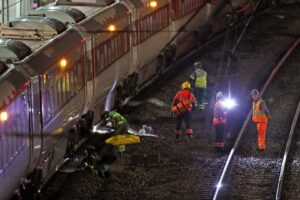
Consequences of a recent Russian attack in Hora village, Kyiv Oblast, Ukraine on July 3, 2025. (Anna Donets/The Kyiv Independent)
KYIV OBLAST — The first night the Lypko family fled their house during a Russian attack was the night it got hit.
For over three years of full-scale war, Vasyl and Natalia Lypko refused to leave their home in Kyiv Oblast, even as Russian drones and missiles flew overhead. When there was an especially big attack, the family crammed in the closet, surrounded on all sides by walls. That seemed safe enough.
But in the early hours of June 23, it got too loud even for them. Drones didn’t just fly by — they were striking nearby. In a split-second decision, they grabbed their two-year-old daughter Leia and the dog they took in when they started building their house six years ago, and rushed to their two cars.
Natalia counted eight drone strikes on the area before they finally drove away.
“Everything was covered in ash,” she recalls. “I was getting my child out while Shahed drones were flying directly toward the car.”
The drones flew low, skimming just above the rooftops as they prepared to strike.
Natalia Lypko, 31, and her daughter Leia, 2, near what is left of their house, destroyed in a Russian attack in June, Hora village, Kyiv Oblast, Ukraine, on July 3, 2025. (Anna Donets/The Kyiv Independent)
As Russia ramps up its aerial strikes, the villages surrounding Kyiv have become more than just a transit route for Russian drones targeting the capital. But if attacks on Kyiv make international headlines, the villages suffer in relative obscurity.
Sometimes the drones pass over the villages en route to the city — a terrifying experience in itself, since they make a loud buzzing noise and can fly in dozens. Other times, they get intercepted here — or even hit the targets in or near the villages themselves.
Residents on the outskirts of Kyiv often hear distant explosions, a sound that signals Russian drones are being downed — or striking something — in the relatively densely populated areas around the city. They range from actual rural villages to affluent places, populated by wealthier Kyivans who prefer to live outside the city. When Russia attacks, they suffer all the same.
In June alone, Russia launched 5,337 drones at Ukraine, breaking the previous monthly record. The attacks have continued into July, with the record-high 741 drones launched overnight on July 9. In mass attacks, Kyiv is usually a priority target — meaning that its surrounding villages, too, suffer. Unlike in the city, there is no metro or other safe bomb shelters. A house basement usually has to suffice — if the house has one.
Roses grow near the houses destroyed in recent Russian attacks in Hora village, Kyiv Oblast, Ukraine on July 3, 2025. (Anna Donets/The Kyiv Independent)
Once his family was safe, Vasyl drove back to the house to retrieve documents. On the way, he stopped to speak briefly with a neighbor — a conversation he now believes saved his life. Moments later, a missile struck the Lypkos’ house.
According to local authorities, the village was attacked by more than 20 drones in a single night. Twenty-six houses suffered, three of them completely destroyed.
“I am grateful that our family is alive,” Natalia told the Kyiv Independent as her husband was searching through the ruins of their home days after the attack, hoping to find anything that had been spared.
“Yet the house is my pain,” she goes on. “We put so much of our soul into it. We built it ourselves, brought everything into that home, and then to see it destroyed before your eyes, to watch it burn — and no one could do anything.”
As night falls
In Kyiv’s suburbs, residents vividly recall the recent large-scale attacks and fear that Russia may intensify strikes by fall.
“They shoot them (the drones) down very often. And when you look out the window, it’s just like Star Wars. Somehow, it’s not the same level of noise and fear (as before),” says Natalia, a 49-year-old saleswoman at a pet store in Hora, an affluent village some 30 kilometers (18 miles) east from the capital, who wasn’t comfortable being identified as she was talking to the journalists on this topic.
“That night (on June 23), it was as scary as on the first day (of the full-scale war). When we didn’t know what it was, we didn’t understand that the war had started — it was confusing and very scary.”
“There’s really no such place where (one could hide) — we wouldn’t have even made it out, because everything was burning.”
Many residents say that now, whenever they see a warning on Telegram channels about drones or missiles being launched by Russia and heading towards the region, they seek shelter. Up until a few weeks ago, they often stayed home.
But rural areas remain critically underprepared for civilian protection. In Kyiv, people can hide in the metro during attacks. In villages, however, there are few dedicated shelters.
Hora, home to roughly 3,700 residents, has only two shelters for the entire village. Without alternatives, people turn to basements or root cellars — underground spaces originally built for food storage — which offer basic shelter at best.
Vasyl Lypko, 46, near his destroyed house in Hora village, Kyiv Oblast, Ukraine on July 3, 2025. (Anna Donets/The Kyiv Independent)The remains of the house of Vasyl and Natalia Lypko in Hora village, Kyiv Oblast, Ukraine, on July 3, 2025. (Anna Donets/The Kyiv Independent)
Many villagers said these spaces are often their only option during attacks. At the same time, those whose homes were completely destroyed say that in the case of a direct Russian strike, the chances of surviving in a basement are slim.
“Nothing could have saved us,” said Vasyl Lypko, whose family used to use their closet as a shelter. “There’s really no such place where (one could hide) — we wouldn’t have even made it out, because everything was burning.”
Swarms of drones
Kyiv and its surrounding region, or oblast, have seen an unprecedented surge in Russian drone and missile attacks.
The escalation began in late May and peaked on the night of June 1, when Russia launched 472 Shahed kamikaze drones in a single attack.
Since the start of its full-scale invasion in February 2022, Russia has launched over 28,000 Shahed drones at Ukraine, President Volodymyr Zelensky said last month.
Russian recent attacks come in waves: swarms of drones to probe and overwhelm defenses, followed by missile barrages, including ballistic strikes, and then another wave of drones. Some believe the missile strikes are part of a “double tap” tactic, aimed at hitting first responders who may have already arrived at the scene of the initial strike.
While much of the focus remains on the city of Kyiv, the surrounding oblast has increasingly become both a buffer zone and a target itself. Authorities report seven Russian attacks on Kyiv Oblast in June and 11 more in July, targeting multiple districts near Kyiv including Bila Tserkva, Boryspil, Brovary, Bucha, Vyshhorod, Obukhiv, and Fastiv.
Kyiv Oblast Governor Mykola Kalashnyk reported that over 120 houses in the region have been damaged to varying degrees in two months, with one person killed and 15 others injured.
Ukrainian authorities largely do not disclose the consequences of Russian attacks against military and strategic targets, making the full extent of damage and casualties difficult to independently establish.
Lidia Nabotova, 58, an employee of Ukrposhta, Ukraine’s state-owned postal service, at her workplace at the post office in Markhalivka village, Kyiv Oblast, Ukraine on July 3, 2025. (Anna Donets / The Kyiv Independent)The remains of a house hit by a Russian aerial attack in Markhalivka village, Kyiv Oblast, Ukraine on July 3, 2025. (Anna Donets / The Kyiv Independent)
“They will be wiping Kyiv out,” says Lidia Nabotova, a resident of the village of Markhalivka, some 30 kilometers (18 miles) south from the capital. Despite the increased danger for her village, she spoke about the need to protect the capital. “We need to allocate every single penny, and defend Kyiv.”
Ukrainian mobile air defense teams — fast-moving units tasked with spotting and downing Russian drones — work around the clock.
Russia’s drone strategy is evolving, says Volodymyr, who heads a volunteer air defense mobile group in Bohuslav, a town some 100 km (62 miles) south of Kyiv. Drones now fly faster and higher before dropping lower to strike, and are harder to intercept. Due to security concerns, he’s not identified by his full name.
They now often change their flight paths mid-air, forcing Ukrainian defenders to stay on the move. Kyiv Oblast, in fact, is a “shield” for the capital, Volodymyr says, with defense systems targeting drones before they reach the city.
“He (Russian President Vladimir Putin) can be sending a thousand drones at once, or more — so what are you going to do?” he said. “His job is to force us to surrender. Our job is to withstand it.”
The sense of home
Despite the danger, many villagers choose to stay.
Eighty-year-old Ivan Fedorenko sits on a swing outside what remains of his house — the burned skeletal frame of the building. Its brick walls were charred, the roof collapsed, and the interior completely destroyed by fire. It’s been two months since a Russian attack destroyed it.
Ivan Fedorenko, 80, a retired general and ex-head of the National Olympic Committee of Ukraine, near his destroyed house in Markhalivka village, Kyiv Oblast, Ukraine on July 3, 2025. (Anna Donets/The Kyiv Independent)
“God pulled you out of the mouth of death and said that today is your (new) birthday — May 25, 2025,” Fedorenko says, recalling the night a massive Russian strike obliterated an entire street in Markhalivka. The attack killed one person and injured eight others, including a child.
That night, he woke up to the roof collapsing on him. He would later learn that a missile struck his house — luckily for Fedorenko, not the part where he slept. He managed to crawl out. His wife also survived. The flames quickly engulfed the house. Their three dogs died in the fire.
“I sat right here and started pulling the shards of glass from my feet,” he said.
“Everything was set up here for living and relaxing. To be living and helping my children, grandchildren, and great-grandchildren,” Fedorenko said.
A former head of Ukraine’s National Olympic Committee and long-serving sports official, Fedorenko lost all of his belongings, including state awards he had received during his lifetime.
Remains of the houses destroyed in recent Russian attacks in Hora village, Kyiv Oblast, Ukraine on July 3, 2025. (Anna Donets/The Kyiv Independent)
The house can’t be rebuilt. For now, Fedorenko lives in the neighboring village. On the day the Kyiv Independent visited Markhalivka, the man came to his old house — not to retrieve anything, but to mow the lawn.
He borrows a mower from neighbors and tends to the lawn — a strip of green oddly intact near the scorched house.
“You know, when I worked in sports, I always said the lawn is where you find pleasure, where you walk barefoot,” he said. “That’s how it was. That’s how beautiful it was.”
Note from the author:
Hello there! This is Kateryna Denisova, the author of this piece. I wrote it to show the human cost of Russia’s brutal war — the stories that often go unseen behind the headlines. My colleagues and I are working around the clock to keep you informed. Please consider supporting our reporting. This makes our work possible.
Thank you.
The hope and horror of 12 hours in wartime Kyiv — in pictures
Life doesn’t pause for war — not entirely. Even as missiles and drones target Ukrainian cities and front lines shift, people find ways to carry on. For those not holding a weapon, survival means more than staying alive. It also means showing up to work, gathering with friends, keeping routines stitched together with fragile hope. In Ukraine, it also means going out to protest against the government — because even amid the chaos of war, there are moments when silence feels more dangerous than sp





